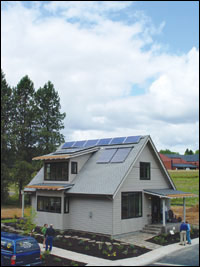Last week the Center for American Progress began a series called “It’s Easy Being Green,” meant to recognize the steps communities, individuals, and organizations are taking to transform our country’s energy use. Last week’s column featured a new kind of neighborhood:
 Pringle Creek Community in Salem, Ore., named the 2007 Green Land Development of the Year by the National Association of Home Builders, may be the greenest neighborhood in the country. It uses 35 sustainable goals to guide planning and construction, including building an entire neighborhood of carbon neutral homes, encouraging contractors to use biodiesel, and creating a community garden.
Pringle Creek Community in Salem, Ore., named the 2007 Green Land Development of the Year by the National Association of Home Builders, may be the greenest neighborhood in the country. It uses 35 sustainable goals to guide planning and construction, including building an entire neighborhood of carbon neutral homes, encouraging contractors to use biodiesel, and creating a community garden.
All development homes can employ a geothermal heating and cooling system that reduces heating bills to a quarter of conventional costs, and homes outfitted with solar-generating photovoltaic cells can bring their bills to zero.
The new homes, built while preserving 80 percent of existing trees, are constructed with 100 percent Forest Stewardship Council-certified lumber. Neighborhood streets use porous paving permitting 90 percent of rainwater to go through asphalt and concrete, eventually entering the aquifer as clean water.
A custom home nearing completion is listed for $432,000. The 1,460-square-foot home scored 103 points from the U.S. Green Building Council’s Leadership in Energy and Environmental Design, which is the highest score ever recorded by LEED.
The community is also working on a sustainable living center that will serve as an educational tool offering hands-on and experiential learning, and social and educational events.
This post was created for ClimateProgress.org, a project of the Center for American Progress Action Fund.


